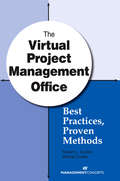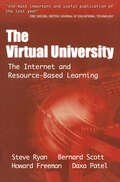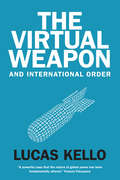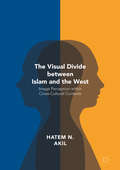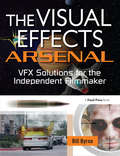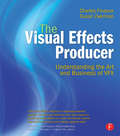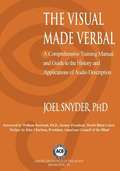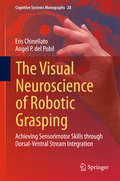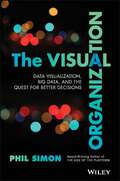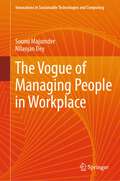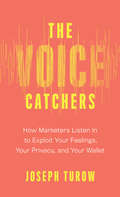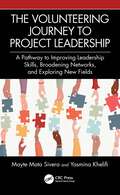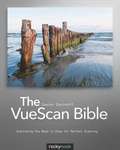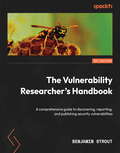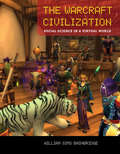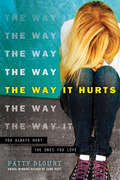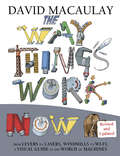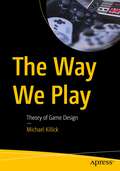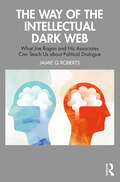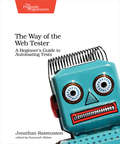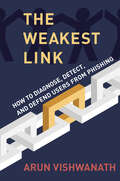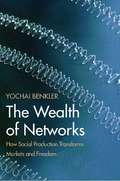- Table View
- List View
The Virtual Project Management Office: Best Practices, Proven Methods
by Robert L. Gordon DM Wanda Curlee DM, PMP, PgMP, PMI-RMPSuccessfully Launch and Operate a Virtual Project Management OfficeNew technology and global businesses and organizations are making virtual project management offices (VPMOs) more important and more prevalent than ever. Successfully operating a VPMO requires project managers to employ additional skills and address different challenges from those necessary to operate a traditional PMO. For example, the virtual project manager must have effective soft skills to build trust among a dispersed team and to select the best forms of communication. He or she must also ensure compliance with the unique policies, procedures, and laws relevant to maintaining a VPMO.This book offers best practices for successful virtual projects and the most effective ways to create and implement a PMO in a virtual environment. It's a valuable resource for companies considering a VPMO and those already operating one.You'll find:- Proven implementation plans- Guidance for building a business case- Laws and ethics governing VPMOs- Tips and advice from expertsPlus! Dozens of practical tools to use in launching a VPMO or improving an existing project management office.
The Virtual University: The Internet and Resource-based Learning (Open and Flexible Learning Series)
by Howard Freeman Bernard Scott Steve Ryan Daxa PatelA discussion of the increased accessibility to the Internet and how this has lead to a variety of resources being used for learning. Case studies and examples show the benefits of using the Internet as part of resource-based learning.
The Virtual Weapon and International Order
by Lucas KelloAn urgently needed examination of the current cyber revolution that draws on case studies to develop conceptual frameworks for understanding its effects on international order The cyber revolution is the revolution of our time. The rapid expansion of cyberspace brings both promise and peril. It promotes new modes of political interaction, but it also disrupts interstate dealings and empowers non-state actors who may instigate diplomatic and military crises. Despite significant experience with cyber phenomena, the conceptual apparatus to analyze, understand, and address their effects on international order remains primitive. Here, Lucas Kello adapts and applies international relations theory to create new ways of thinking about cyber strategy. Kello draws on a broad range of case studies, including the Estonian crisis, the Olympic Games operation against Iran, and the cyber attack against Sony Pictures. Synthesizing qualitative data from government documents, forensic reports of major incidents and interviews with senior officials from around the globe, this important work establishes new conceptual benchmarks to help security experts adapt strategy and policy to the unprecedented challenges of our times.
The Visual Divide between Islam and the West
by Hatem N. AkilThis book considers the ways in which Muslims view the way they are being viewed, not viewed, or incorrectly viewed, by the West. The book underscores a certain "will-to-visibility" whereby Muslims/ Arabs wish just to be "seen" and to be marked as fellow human beings. The author relates the failure to achieve this visibility to a state of desperation that inextricably and symmetrically ties visibility to violence. When Syrian and Palestinian refugees recently started refusing to be photographed, they clearly ushered the eventual but inevitable collapse of the image and its final futility. The photograph has been completely emptied of its last remaining possibility of signification. The book attempts to engage with questions about the ways in which images are perceived within cross cultural contexts. Why and how do people from different cultural backgrounds view the same image in opposing ways; why do cartoon, photographs, and videos become both the cause and target of bloody political violence - as witnessed recently by the deadly attacks against Charlie Hebdo in France and in the swift military response by the US, Jordan, France, and others to videotaped violence by ISIS.
The Visual Effects Arsenal: VFX Solutions for the Independent Filmmaker
by Bill ByrneBuild your VFX arsenal with quick-access, step-by-step instruction on how to create today's hottest digital VFX shots. This essential toolkit provides techniques for creating effects seen in movies such as 300, Spiderman 3, Predator and others, with lessons on how-to:* splatter blood or digitally lop someone's arm off* create a scene with actors running from an explosion* create the "twin effect" (same actor, same location, 2 performances)* produce space-ship dog fightsOrganized in a 'cookbook' style, this allows you to reference a certain effect in the index and immediately access concise instructions to create that effect. Techniques are demonstrated in each of the most popular software tools- After Effects, Final Cut Studio, Photoshop, and Combustion are all covered. Brilliant, 4-color presentation provides inspiration and stimulating visual guidance to the lessons presented, while the downloadable resources contain project media files enabling you to put concepts learned into immediate practice.
The Visual Effects Producer: Understanding the Art and Business of VFX
by Susan Zwerman Charles FinanceFirst published in 2010. Routledge is an imprint of Taylor & Francis, an informa company.
The Visual Made Verbal: A Comprehensive Training Manual and Guide to the History and Applications of Audio Description
by Joel SnyderVerbal descriptions of life have been around for centuries, but the digital age has made access to those descriptions even more important. Dr. Joel Snyder, an audio description pioneer, has created a book and website offering the first overview of the field, including its history, application to a range of genres, description of training techniques and list of resources. Audio description brings the visual world to life, making theater productions, television shows, films, visual art and events accessible to people who are blind or have low vision. Describers employ succinct, vivid, imaginative words to convey visual images those with sight take for granted. Although countries worldwide have taken up the cause, the United States has fallen short on research and institutions to study the field. Dr. Snyder's book helps fill in some of those gaps. "For decades, Joel Snyder has combined his astonishing command of language with his keen attention to detail to create word pictures that stir the mind's eye, especially for patrons of the arts whose physical eyes cannot see. ... His book has been long-awaited and no doubt will become the standard for prospective audio describers around the world." -- Kelsey Marshall, founding director of accessibility, John F. Kennedy Center for the Performing Arts in Washington, D.C. Dr. Joel Snyder is known internationally as one of the world's first "audio describers," a pioneer in the field of audio description: making theater events, museum exhibitions, and media accessible to people who are blind or have low vision. Since 1981, he has introduced audio description techniques in 36 states and D.C. and in 35 countries; he holds a Ph.D. in accessibility-audio description from the Universitat Autonoma de Barcelona. Dr. Snyder's company, Audio Description Associates, LLC (www.audiodescribe.com) uses audio description to enhance a wide range of arts projects including video and film, museum exhibitions and live events, As Director of Described Media for the National Captioning Institute, he supervised the production of description for Sesame Street and dozens of feature films and nationally broadcast television; his descriptions can be heard at Smithsonian Institution exhibits, the Getty Museum, the Albright-Knox Gallery and throughout the country at National Park Service visitor centers. As Director of the American Council of the Blind's Audio Description Project (www.acb.org/adp), Dr. Snyder voiced description for network coverage of President Obama's inauguration in 2009 and 2013 and recently produced the first-ever audio described tour of The White House; the ADP website is the nation's principal provider of information and resources on audio description.
The Visual Neuroscience of Robotic Grasping
by Eris Chinellato Angel P. PobilThis book presents interdisciplinary research that pursues the mutual enrichment of neuroscience and robotics. Building on experimental work, and on the wealth of literature regarding the two cortical pathways of visual processing - the dorsal and ventral streams - we define and implement, computationally and on a real robot, a functional model of the brain areas involved in vision-based grasping actions. Grasping in robotics is largely an unsolved problem, and we show how the bio-inspired approach is successful in dealing with some fundamental issues of the task. Our robotic system can safely perform grasping actions on different unmodeled objects, denoting especially reliable visual and visuomotor skills. The computational model and the robotic experiments help in validating theories on the mechanisms employed by the brain areas more directly involved in grasping actions. This book offers new insights and research hypotheses regarding such mechanisms, especially for what concerns the interaction between the dorsal and ventral streams. Moreover, it helps in establishing a common research framework for neuroscientists and roboticists regarding research on brain functions.
The Visual Organization
by Phil SimonThe era of Big Data as arrived, and most organizations are woefully unprepared. Slowly, many are discovering that stalwarts like Excel spreadsheets, KPIs, standard reports, and even traditional business intelligence tools aren't sufficient. These old standbys can't begin to handle today's increasing streams, volumes, and types of data. Amidst all of the chaos, though, a new type of organization is emerging. In The Visual Organization, award-winning author and technology expert Phil Simon looks at how an increasingly number of organizations are embracing new dataviz tools and, more important, a new mind-set based upon data discovery and exploration. Simon adroitly shows how Amazon, Apple, Facebook, Google, Twitter, and other tech heavyweights use powerful data visualization tools to garner fascinating insights into their businesses. But make no mistake: these companies are hardly alone. Organizations of all types, industries, sizes are representing their data in new and amazing ways. As a result, they are asking better questions and making better business decisions.Rife with real-world examples and case studies, The Visual Organization is a full-color tour-de-force.
The Vogue of Managing People in Workplace (Innovations in Sustainable Technologies and Computing)
by Nilanjan Dey Soumi MajumderThis book provides a detailed vogue picture of workforce management. Nowadays, the methodology of people management has been more advanced and dynamic; it becomes highly competitive. Keeping in mind the significance of economic and social development of the country, the author has tried to draw attention on innovative and creative practices of workforce retention in business. The book provides an idea on the way of merchandising with people, cultural dynamics with impacted leadership, investment in people for organizational transformation and the future of people management with artificial intelligence.
The Voice Catchers: How Marketers Listen In to Exploit Your Feelings, Your Privacy, and Your Wallet
by Joseph TurowYour voice as biometric data, and how marketers are using it to manipulate you Only three decades ago, it was inconceivable that virtually entire populations would be carrying around wireless phones wherever they went, or that peoples&’ exact locations could be tracked by those devices. We now take both for granted. Even just a decade ago the idea that individuals&’ voices could be used to identify and draw inferences about them as they shopped or interacted with retailers seemed like something out of a science fiction novel. Yet a new business sector is emerging to do exactly that. The first in-depth examination of the voice intelligence industry, The Voice Catchers exposes how artificial intelligence is enabling personalized marketing and discrimination through voice analysis. Amazon and Google have numerous patents pertaining to voice profiling, and even now their smart speakers are extracting and using voice prints for identification and more. Customer service centers are already approaching every caller based on what they conclude a caller&’s voice reveals about that person&’s emotions, sentiments, and personality, often in real time. In fact, many scientists believe that a person&’s weight, height, age, and race, not to mention any illnesses they may have, can also be identified from the sound of that individual&’s voice. Ultimately not only marketers, but also politicians and governments, may use voice profiling to infer personal characteristics for selfish interests and not for the benefit of a citizen or of society as a whole. Leading communications scholar Joseph Turow places the voice intelligence industry in historical perspective, explores its contemporary developments, and offers a clarion call for regulating this rising surveillance regime.
The Volunteering Journey to Project Leadership: A Pathway to Improving Leadership Skills, Broadening Networks, and Exploring New Fields
by Mayte Mata Sivera Yasmina KhelifiThe project management profession has grown through the hard work of many volunteer groups and organizations. The Volunteering Journey to Project Leadership explains how volunteering can help project management professionals grow their own capabilities and careers. It explains how volunteering in project-oriented organizations, or any organization where projects are delivered, can help project managers develop leadership skills, build strong and diverse networks, and gain experiences in new fields. Any project manager or PMO can get advice and insights from this book, which explains how to: Identify volunteering goals that align with career goals Find the right organization that complements professional aspiration Choose activities for enhancing careers in project leadership Strategically select the right role to advance careers Based on the authors’ own volunteering and professional experiences, as well as interviews and informal discussion with more than 100 volunteers, this book is a hands-on guide to personal and professional growth in the field of project management. It is structured in three parts. Part I describes four ways volunteering can develop project leadership abilities. Part II focuses on leadership and adaptative skills, networking, and new skills gained by experimenting. Part III consolidates the learning and explains how to apply it at work. Each chapter ends with practical case studies, detailed interviews, key takeaways, and questions to reflect on.
The VueScan Bible
by Sascha SteinhoffVueScan is the world's most widely used software interface for digitizing film and prints on flatbed and film scanners. This powerful yet affordable program supports over 1500 scanners and 321 digital camera RAW file types, and is available for Mac OS X, Windows, and Linux. Much more than a simple scanner program, VueScan allows you to perform functions such as color restoration, adding sharpening filters, adjusting white balance, rotating images, and batch scanning multiple images. It also provides output to a variety of formats including TIFF, JPEG, and searchable PDF files (even all three simultaneously). The Pro version outputs to the RAW format and provides options for color adjustments, and more. Despite its popularity, the documentation for VueScan does not provide enough information to use the full power of the system and makes it difficult to get started. The VueScan Bible is the missing manual for new, experienced, and prospective users of VueScan.
The Vulnerability Researcher's Handbook: A comprehensive guide to discovering, reporting, and publishing security vulnerabilities
by Benjamin StroutLearn the right way to discover, report, and publish security vulnerabilities to prevent exploitation of user systems and reap the rewards of receiving credit for your workKey FeaturesBuild successful strategies for planning and executing zero-day vulnerability researchFind the best ways to disclose vulnerabilities while avoiding vendor conflictLearn to navigate the complicated CVE publishing process to receive credit for your researchBook DescriptionVulnerability researchers are in increasingly high demand as the number of security incidents related to crime continues to rise with the adoption and use of technology. To begin your journey of becoming a security researcher, you need more than just the technical skills to find vulnerabilities; you'll need to learn how to adopt research strategies and navigate the complex and frustrating process of sharing your findings. This book provides an easy-to-follow approach that will help you understand the process of discovering, disclosing, and publishing your first zero-day vulnerability through a collection of examples and an in-depth review of the process.You'll begin by learning the fundamentals of vulnerabilities, exploits, and what makes something a zero-day vulnerability. Then, you'll take a deep dive into the details of planning winning research strategies, navigating the complexities of vulnerability disclosure, and publishing your research with sometimes-less-than-receptive vendors.By the end of the book, you'll be well versed in how researchers discover, disclose, and publish vulnerabilities, navigate complex vendor relationships, receive credit for their work, and ultimately protect users from exploitation. With this knowledge, you'll be prepared to conduct your own research and publish vulnerabilities.What you will learnFind out what zero-day vulnerabilities are and why it's so important to disclose and publish themLearn how vulnerabilities get discovered and published to vulnerability scanning toolsExplore successful strategies for starting and executing vulnerability researchDiscover ways to disclose zero-day vulnerabilities responsiblyPopulate zero-day security findings into the CVE databasesNavigate and resolve conflicts with hostile vendorsPublish findings and receive professional credit for your workWho this book is forThis book is for security analysts, researchers, penetration testers, software developers, IT engineers, and anyone who wants to learn how vulnerabilities are found and then disclosed to the public. You'll need intermediate knowledge of operating systems, software, and interconnected systems before you get started. No prior experience with zero-day vulnerabilities is needed, but some exposure to vulnerability scanners and penetration testing tools will help accelerate your journey to publishing your first vulnerability.
The War Against the BBC: How an Unprecedented Combination of Hostile Forces Is Destroying Britain's Greatest Cultural Institution... And Why You Should Care
by Patrick Barwise Peter YorkThere's a war on against the BBC. It is under threat as never before. And if we lose it, we won't get it back.The BBC is our most important cultural institution, our best-value entertainment provider, and the global face of Britain. It's our most trusted news source in a world of divisive disinformation. But it is facing relentless attacks by powerful commercial and political enemies, including deep funding cuts - much deeper than most people realise - with imminent further cuts threatened. This book busts the myths about the BBC and shows us how we can save it, before it's too late.
The Warcraft Civilization: Social Science in a Virtual World (The\mit Press Ser.)
by William Sims BainbridgeAn exploration of the popular online role-playing game World of Warcraft as a virtual prototype of the real human future.World of Warcraft is more than a game. There is no ultimate goal, no winning hand, no princess to be rescued. WoW is an immersive virtual world in which characters must cope in a dangerous environment, assume identities, struggle to understand and communicate, learn to use technology, and compete for dwindling resources. Beyond the fantasy and science fiction details, as many have noted, it's not entirely unlike today's world. In The Warcraft Civilization, sociologist William Sims Bainbridge goes further, arguing that WoW can be seen not only as an allegory of today but also as a virtual prototype of tomorrow, of a real human future in which tribe-like groups will engage in combat over declining natural resources, build temporary alliances on the basis of mutual self-interest, and seek a set of values that transcend the need for war.What makes WoW an especially good place to look for insights about Western civilization, Bainbridge says, is that it bridges past and future. It is founded on Western cultural tradition, yet aimed toward the virtual worlds we could create in times to come.
The Water Engine: Editorial Alvi Books
by Ares Van JaagThe "water engine" is an invention unfortunately invented many times. Hydrogen from water is very abundant, renewable and can be used in both energy poor and rich countries. Crude oil and natural gas are limited energy resources. But there are many people who think that certain promising technologies have been suppressed by various political or economic powers, usually with the purpose of protecting their investments and interests and, at the already more absurd extremes of the conspiracy illogical, for sinister motivations of much greater scope. In this new work, the versatile composer and writer Van Jaag, accompanies us on an exciting journey through the history of this unknown invention and its invented inventors.
The Wave Three Way To Building Your Downline
by Richard PoeThe face of home business has changed in recent years. People are building businesses based on good products, treating each other well, and using the power of internet technology. Now millions of people just like you are learning to make a living from home. In this book you'll find dozens of stories of people from soccer moms to beach bums and fortune 500 executives and how they learned to make a living from home. They show you how you can too.
The Way It Hurts
by Patty BlountThere may be two sides to every story, but sometimes there's only one way to set things right...Music is Elijah's life. His band plays loud and hard, and he'll do anything to get them a big break. He needs that success to help take care of his sister, who has special needs. So he'd rather be practicing when his friends drag him to a musical in the next town...until the lead starts to sing.Kristen dreams of a career on stage like her grandmother's. She knows she needs an edge to get into a competitive theater program—and being the star in her high school musical isn't going to cut it. The applause and the attention only encourage her to work harder.Elijah can't take his eyes off of Kristen's performance, and his swooning face is captured on camera and posted with an out-of-context comment. It goes viral. Suddenly, Elijah and Kristen are in a new spotlight as the online backlash spins out of control. And the consequences are bigger than they both could have ever imagined because these threats don't stay online...they follow them into real life.
The Way Things Work Now
by David MacaulayA New York Times Bestseller Explainer-in-Chief David Macaulay updates the worldwide bestseller The New Way Things Work to capture the latest developments in the technology that most impacts our lives. Famously packed with information on the inner workings of everything from windmills to Wi-Fi, this extraordinary and humorous book both guides readers through the fundamental principles of machines, and shows how the developments of the past are building the world of tomorrow. This sweepingly revised edition embraces all of the latest developments, from touchscreens to 3D printer. Each scientific principle is brilliantly explained--with the help of a charming, if rather slow-witted, woolly mammoth. An illustrated survey of significant inventions closes the book, along with a glossary of technical terms, and an index. What possible link could there be between zippers and plows, dentist drills and windmills? Parking meters and meat grinders, jumbo jets and jackhammers, remote control and rockets, electric guitars and egg beaters? Macaulay explains them all.
The Way We Play: Theory of Game Design
by Michael KillickGain insight into what it takes to design and develop your first video game. This book offers a peek behind the scenes, where you will find in-depth knowledge of game design theory and insight into the technical and design aspects of video game development. The Way We Play allows you to explore game design and theory while also learning the nuances of how games in different genres should be approached, their workings, and successful unique selling points in a competitive gaming field. As you progress further into the book, BAFTA Nominated Young Games Design Mentor Michael Killick walks you through the more technical aspects of game development and shares techniques that will enable you to take your first steps in designing your own games. Upon completing this book, you will have a firm understanding of the gaming industry, from theory through design and production. What You Will Learn Understand theories within games designGrasp what it takes to design and create your first gameLook back at previous popular games and what made them so greatCover all aspects of design to allow you to begin designing your first video game Who Is This Book For: Anyone who would like to explore the fundamentals of game design and the theory behind it. This is also a chance to learn what goes into a game and how a game can be designed to be fun.
The Way of the Intellectual Dark Web: What Joe Rogan and His Associates Can Teach Us about Political Dialogue
by Jamie Q RobertsRoberts presents a rigorous and accessible assessment of the Intellectual Dark Web’s origins, shared philosophy, cultural importance, and limitations. Since the mid-2010s, the Intellectual Dark Web (IDW) has been an unprecedented cultural and intellectual phenomenon. Using primarily podcasts and YouTube videos, a new generation of public intellectuals has appeared, loosely coalesced, and gained a vast global audience. This movement has encompassed a range of individuals, notably Joe Rogan, Jordan Peterson, Eric and Bret Weinstein, Ben Shapiro, Heather Heying, and Sam Harris. Other names more broadly associated with the grouping have included Steven Pinker, Jonathan Haidt, Elon Musk, Niall Ferguson, and Stephen Fry. There is a sprawling and ever-growing list of those who have appeared on IDW podcasts and videos, started their own podcasts along similar lines, and share a general ethos. It is a dispersed movement, but a significant one, given the reach of these various online outlets is in the millions globally. Roberts draws together and synthesises the core ideas espoused by the members of this movement and critically assesses its origins, coherence, and the impact it has had on politics and public discourse. He asks – to what extent has the IDW lived up to its professed goal of moving beyond polarisation and radicalisation? An insightful read both for followers of the IDW looking for a coherent and critical overview and for students of popular culture looking to understand this massive but decentralised popular intellectual movement.
The Way of the Web Tester: A Beginner's Guide to Automating Tests
by Jonathan RasmussonThis book is for everyone who needs to test the web. As a tester, you'll automate your tests. As a developer, you'll build more robust solutions. And as a team, you'll gain a vocabulary and a means to coordinate how to write and organize automated tests for the web. Follow the testing pyramid and level up your skills in user interface testing, integration testing, and unit testing. Your new skills will free you up to do other, more important things while letting the computer do the one thing it's really good at: quickly running thousands of repetitive tasks.This book shows you how to do three things: How to write really good automated tests for the web. How to pick and choose the right ones.* How to explain, coordinate, and share your efforts with others.If you're a traditional software tester who has never written an automated test before, this is the perfect book for getting started. Together, we'll go through everything you'll need to start writing your own tests.If you're a developer, but haven't thought much about testing, this book will show you how to move fast without breaking stuff. You'll test RESTful web services and legacy systems, and see how to organize your tests.And if you're a team lead, this is the Rosetta Stone you've been looking for. This book will help you bridge that testing gap between your developers and your testers by giving your team a model to discuss automated testing, and most importantly, to coordinate their efforts.The Way of the Web Tester is packed with cartoons, graphics, best practices, war stories, plenty of humor, and hands-on tutorial exercises that will get you doing the right things, the right way.
The Weakest Link: How to Diagnose, Detect, and Defend Users from Phishing
by Arun VishwanathAn expert in cybersecurity lays out an evidence-based approach for assessing user cyber risk and achieving organizational cyber resilience.Phishing is the single biggest threat to cybersecurity, persuading even experienced users to click on hyperlinks and attachments in emails that conceal malware. Phishing has been responsible for every major cyber breach, from the infamous Sony hack in 2014 to the 2017 hack of the Democratic National Committee and the more recent Colonial Pipleline breach. The cybersecurity community&’s response has been intensive user training (often followed by user blaming), which has proven completely ineffective: the hacks keep coming. In The Weakest Link, cybersecurity expert Arun Vishwanath offers a new, evidence-based approach for detecting and defending against phishing—an approach that doesn&’t rely on continual training and retraining but provides a way to diagnose user vulnerability. Vishwanath explains how organizations can build a culture of cyber safety. He presents a Cyber Risk Survey (CRS) to help managers understand which users are at risk and why. Underlying CRS is the Suspicion, Cognition, Automaticity Model (SCAM), which specifies the user thoughts and actions that lead to either deception by or detection of phishing come-ons. He describes in detail how to implement these frameworks, discussing relevant insights from cognitive and behavioral science, and then presents case studies of organizations that have successfully deployed the CRS to achieve cyber resilience. These range from a growing wealth management company with twenty regional offices to a small Pennsylvania nonprofit with forty-five employees. The Weakest Link will revolutionize the way managers approach cyber security, replacing the current one-size-fits-all methodology with a strategy that targets specific user vulnerabilities.
The Wealth of Networks
by Yochai BenklerWith the radical changes in information production that the Internet has introduced, we stand at an important moment of transition, says Yochai Benkler in this thought-provoking book. The phenomenon he describes as social production is reshaping markets, while at the same time offering new opportunities to enhance individual freedom, cultural diversity, political discourse, and justice. But these results are by no means inevitable: a systematic campaign to protect the entrenched industrial information economy of the last century threatens the promise of today's emerging networked information environment. In this comprehensive social theory of the Internet and the networked information economy, Benkler describes how patterns of information, knowledge, and cultural production are changing-and shows that the way information and knowledge are made available can either limit or enlarge the ways people can create and express themselves. He describes the range of legal and policy choices that confront us and maintains that there is much to be gained-or lost-by the decisions we make today.
